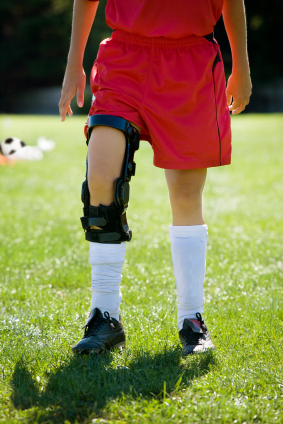Anterior cruciate ligament (ACL) injuries do not disproportionately affect female athletes, occur more often from player-to-player contact, and far more frequently in competition than practice than previously believed, finds a surprising and important new study. [1]
"ACL injuries are traditionally regarded as a female athlete issue, yet this study found no significant gender difference in injury rates when all nine sports were considered," says Dawn Comstock, Associate Professor, Colorado School of Public Health, and Principal Investigator for the High School RIO, TM the internet-based data collection tool researchers at Nationwide Children's Hospital in Columbus, Ohio and the University of Colorado at Denver used in the study.

Only when sex-comparable sports (soccer, basketball, and baseball or softball) were considered were girls found to have a significantly higher ACL injury rate than boys, with girls 2 times more likely to suffer an ACL injury playing soccer than any other sport, and 4 times more likely to sustain such an injury playing either soccer or basketball than volleyball or softball.
Football has most injuries
Not surprisingly, football, the high school sport with the greatest number of participants by a wide margin, accounted for the largest number of ACL injuries.
What came as a surprise was that football had the highest competition-related ACL injury rate of the nine sports studied, with boys 4 times more likely to sustain an ACL injury playing football than any other boys' sport.
Although ACL injuries accounted for just twenty percent of all knee injuries - a decrease from the 50% or more reported in prior studies researchers found "encouraging" - they emphasized that "ACL injuries still represent an important burden to high school athletes, as they often require surgical repair followed by extensive long-term rehabilitation; they can mean the end of an athlete's competitive career, and they have been linked with negative long-term outcomes, including chronic pain and osteoarthritis."
"Rates, however, are only one way to evaluate burden," noted Comstock. "Incidence should also be considered." "Given the large number of US high school football players relative to the number of girls' basketball and soccer players, in terms of the numbers of patients treated, sports medicine clinicians are more likely to treat a male high school athlete with an ACL injury than a female high school athlete with an ACL injury."
Prevention efforts needed
"Although effective injury-prevention programs may need to be sex-specific, given the large number of male athletes sustaining ACL injuries, efforts to create effective programs should not be solely targeted to female athletes ... [but] should be focused on those athletes at highest risk of ACL injury," the study recommends.
The study authors urge coaches and ATs in sports with high rates of ACL injury to take special care to teach sport specific skills (e.g. planting and changing direction, jumping and landing); address neuromuscular strength, and work on coordination of stabilizing muscles about the knee joint through stretching, plyometrics and strength training drills.
"Future studies should focus on the modifiable sport-specific risk factors for ACL injuries," adds Comstock. "This will help drive the development of effective, evidence-based and targeted ACL injury prevention programs."
Until such programs are developed, the authors concluded that the incidence of injury should be expected to rise along with the increasing number of young athletes participating in sports.








